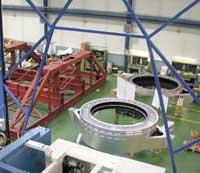Scales of science and technology
However, quantum mechanics puts subtypes to the smallest and the shortest moment imaginable; these limits are those established by the scale of Planck, that is, for every phenomenon of observable physics it is necessary that the object to study is illuminated in some way with electromagnetic radiation. The wavelength of this radiation should be equal to the size of the object to be studied. Thus, as it is immersed in the microscopic world, the length of the radiation wave will be smaller and the quantum of energy it carries will be greater.

This has limitations, since from a certain amount of energy the quantum collapse occurs, as if it were a black hole. From the length measurements of Planck, that is, from 10-35 m, the space-time structure resulting from the General Theory of Relativity makes no sense. Similarly, the time intervals below the one that takes light to travel the length of Planck, under 10 -43”, are not useful in physics. Not at least until the contradictions between General Relativity and Quantum Mechanics are resolved.
Therefore, for the Planck scale of the early moments of the great energies and the Big Bang, the present Physics still has no satisfactory theory. However, theoretical physicists who seek the “Theory of Everything” have advanced a lot in recent decades and believe they can triumph with the “M” theory of superstrings.
Experimental science is starting to combine results and theory, at teraelectronvolt scale (TeV), the energy that will soon get the hadrons circulating in the CERN LHC accelerator “Large Hadron Collider”, or what is the same, between 10 and 15 m (size of protons and neutrons). Curiously, the technology is developing at this level, since there are artificial devices that obtain pulses of several femtoseconds (10 -15”), as for example the laser pulses used in precision micromachining.
From these measures, in fact higher levels, science and technology mix, feed each other and complement each other in progress. In fact, technology is already an atomic scale reality, at amstrong scale (10 -10 m) and more specifically at nanometers and nanotechnology scale. For this purpose are the instruments of tunnel effect and atomic force, with the ability to see and move atoms one by one. There are electromagnetic and mechanical devices to place these devices with incredible precision, although this scale, the mesoscale, still surprises in the world of quantum laws.

Nanotechnology will revolutionize the industry. They are already the most important area of research programs of the American and European institutions, and are the origin of ideas close to fiction. But at the same time they offer real things, like the first molecular rotor. This tool was recently presented by James Gimzewski of the UCLA University. Jumping in size levels we can reach the cell scale, the microns (10-6 m). Microtechnology is a consolidated reality. If the society of information and knowledge is a reality, it is due to the ability to produce elements and semiconductors of microscopic size and lately smaller. Currently microtechnologies are overcoming the limited area of electronic applications and have open the way of high added value electromechanical, optical and optoelectronic devices. The elements of measurement and control of last generation are a sample of it.
The scale of 10 -3 m, apparently more common, can still give many surprises and technological-industrial options, since it produces the miniaturization of many older consumer products already existing. For example, a micromanufacturing workshop has been launched at the Tekniker technology centre. The use of conventional micromilling, precision turning and electroerosion techniques allows for new solutions for automotive, medical surgery, consumer electronics, etc.

Let us leave for a moment the human scale and go to the limits of the known universe. The largest extension used by science is megaparsec. Parseca would be the parallax of a second, that is: Distance to a star with an angle of one second with the Sun and Earth (approximately 3 light years). Also there, although it seems difficult, science and technology go hand in hand.
To know what happened a billion years ago to billions of light years ago (because space travel is obligatory travel to the past), a set of new generation telescopes located on Earth has begun to be used. These telescopes, thanks to their ultra-precision mechanical devices, have begun to overcome the drawbacks that have caused atmospheric perturbations for years. Among these devices is the Gran Telescopio de Canarias en construcción (Grantecan), with a mirror of 10 meters of diameter. In this project, a research centre in the Basque Country has developed Nasmyth devices that move the telescope.
Buletina
Bidali zure helbide elektronikoa eta jaso asteroko buletina zure sarrera-ontzian











